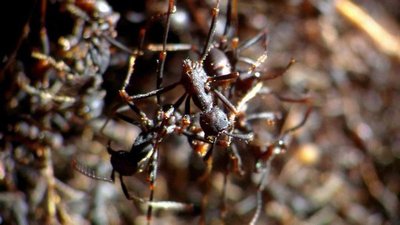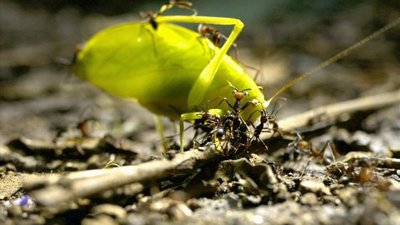November 4, 2010
UW army ant expert advises on National Geographic’s ‘Great Migrations,’ Nov. 7
Sean O’Donnell, UW psychology professor who studies social insects in the tropics, served as a biology consultant for the new television documentary Great Migrations by the National Geographic Channel.
The first episode, Need to Breed, airs at 8 p.m. Nov. 7, and features O’Donnell’s army ant expertise.
Army ants are ideal for this episode, because they go to great lengths to feed their offspring, O’Donnell said. They engulf and incapacitate insects and other small animals up to thousands of times larger than their one centimeter-long bodies. They swarm and rob wasp nests of their larvae, as adult wasps watch helplessly. And searching for new hunting grounds, the ants travel overnight across distances that would be like running a marathon for humans.
O’Donnell traveled with the National Geographic television crew to Costa Rica twice to capture footage of the ants in action. He helped develop the storylines, explained the biology of the ants to the crew and advised them on what footage to be sure to get.
“Army ants are very sensitive to their environment,” O’Donnell said. “We needed to get down with the ants without disturbing them. The challenge was to avoid getting in the swarm ourselves — the workers are quick to deliver painful stings.”
Using macro-photography and a specially-made mobile camera that could be lowered to antennae-level with the ants, the film crew followed the ants through the forest. A high-speed camera — like the technology used in the Matrix movies — allowed the filmmakers to get slow-motion footage of ants attacking prey. With a surgical endoscopy camera, the filmmakers were able to penetrate the ants’ nest and film the larvae sheltered inside.
In one clip, a third of the basketball-sized nest — called a bivouac and constructed of the ants’ claws and feet gripping each other — disassembles and invades a wasp nest. The wasps flee their nest as the ants delve into the honeycombs, remove the larvae and bring them back to their own nest.
In another clip, ants attacked, killed and butchered a large scorpion. It took nearly a full day to film the event, said O’Donnell, who also helped the crew with lighting and some camera work.
“The camera could run with the ants and pan around an individual worker,” O’Donnell said. “The footage not only captures the profound enormity and mobility of the colony, but it also emphasizes the significance of each individual worker.”
The Need to Breed episode also features penguins, albatross, bats, elephant seals and antelope. The seven-part Great Migration series includes episodes Born to Move, Feast or Famine, Race to Survive and Rhythm of Life. In Snohomish and King Counties, National Geographic Channel is Channel 273.
For more information on the series, click here.


